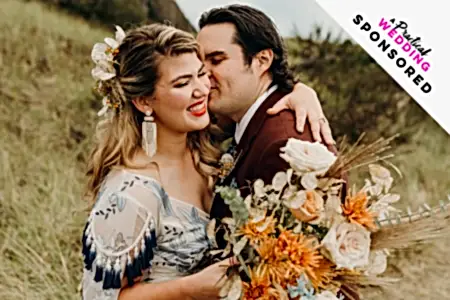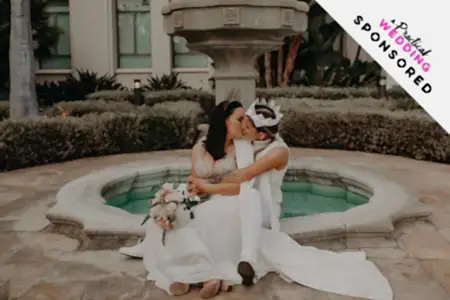Hannah, Writer, Music Teacher, and Yoga Teacher & David, Theatre Teacher
When Jess got married she stitched silk leaves onto her dress: a swoosh of green as she walked the aisle. I stood at the front of the church holding my tears at bay, ready to take her bouquet when she and Anders exchanged rings. I’d traveled from Massachusetts to Perth, Australia to stand beside my childhood best friend as she exchanged her vows. I didn’t tell her that I didn’t believe in marriage any more.
Seven years, one divorce (mine), and two daughters (hers) later, I began planning my second wedding. I’d loved Jess’ green leaves so much that I decided to co-opt the idea. Instead of leaves I’d sew flowers.
I got married for the first time at age eighteen, and wearing a traditional white dress made sense then. I was young, and marrying the boy (er, man) I loved felt clean and simple. Jess and the other bridesmaids wore pale yellow, the color of June sunlight. The second time around, I knew that marriage is neither clean nor simple. It has its summers and its winters, its autumns and its springs. The flowers on my dress would allow me to embody the hues of all seasons: the pale and the bright, the dusky and the dark.
Still better, I decided to ask the important women in my life to sew the flowers. That way even those who couldn’t attend the wedding would accompany me down the aisle. I’d come a long way from rejecting the institution of marriage, but I cherished a healthy skepticism that the love David and I shared would sustain itself by its own magical momentum. We’d need support, and plenty of it.
Four months before our July wedding I scoured craft blogs and settled on a simple flower design: something anyone could sew. All you’d need was a bit of ribbon, a needle, and thread.
In April I traveled to my parents’ house near Philadelphia for a bridal shower with old friends. I prepared a rainbow of ribbon colors with matching spools of thread, but I couldn’t have prepared myself for the experience of watching my friends work. When I created the samples, I had stitched quickly, eager to prove that it was a five-minute project. We’re all so busy, aren’t we? I didn’t want the task to feel laborious or cumbersome. All I wanted was a quick little burst of love, scarcely more time-consuming than typing a Facebook comment or forwarding a funny YouTube video.
But the women at the shower had an entirely different perspective. Their work would appear on my wedding dress, for heaven’s sake. Each flower had to be beautiful. They deliberated over the ribbon hues. Several women stitched two colors together into double-layered flowers. The seamstresses assisted the self-proclaimed un-crafty folks. The project engaged everyone so fully that the buffet stood untouched for the first half hour of the shower.
Back in Massachusetts, I typed up a blog entry with instructions for the project and pictures of the first batch of flowers. To my delight, friends I hadn’t spoken with in years saw the blog on Facebook and let me know their flowers would be in the mail. I thought through my past and emailed the blog link to others: favorite teachers, far-away relatives, and women I’d never meant to lose touch with.
I felt audacious each time I asked someone to create a flower. I typed, “No pressure!” over and over again. With every request I was saying, “Please love me.” I trusted my friends’ love whether they made flowers or not, but summoning the courage to ask for their participation felt like a big deal.
The flower project began as a fun way to add color to a wedding dress, but it evolved into something symbolic. With each request I was wiping away the web of unworthiness that shrouded my mind. It wasn’t just that asking for flowers felt audacious. The whole wedding felt audacious. Didn’t I have a wedding twelve years prior? Hadn’t people poured forth love and gifts and good wishes to me once already? I’d fudged my first marriage. Who was I to deserve a second shot?
But as my friend Doug wrote, “I am convinced that those of us who enter a second marriage, aware and having done the work in between, are the ones most likely to truly get the most out of a union. It’s not a ‘second chance,’ it’s just the natural and amazing journey from asleep to awake, and the opportunity is truly to be cherished and celebrated.” I didn’t regret my first marriage. I carried too many hard-won lessons to wish that time away. And Doug was right. At thirty-two I was far more awake than I’d been at eighteen. Every day I marveled at the ways David and I cherished and celebrated each other. Why not let our community cherish and celebrate us too?
Flowers began to arrive in my mailbox with notes from old friends. Heather’s purple flower brought me back to our childhood in Hawaii. Kathy stitched three flowers: different colors for the different eras of her life that we’d shared. Michèle was going through a time of major transition when she spotted my blog entry; she wrote that sewing the flower felt like therapy. I began to understand that the project wasn’t just about me. People want to participate in the business of loving. All you have to do is invite them.
By the time June rolled around, I’d received well over a hundred ribbon flowers. I had to tie six or seven knots per flower to keep the thread from slipping through the grosgrain sash. I joked with friends that I was tying the knot thousands of times before actually tying the knot. The work felt simultaneously beautiful and mundane: a lot like marriage itself.
David received a job offer in Kansas ten days before the wedding, so we began planning a cross-country move while finishing half a dozen projects and entertaining family. I still had forty-something flowers to add to my sash. I hadn’t intended to ask for anyone’s help, but boy did I need it. Jess arrived from Australia two days before the wedding and put her hands to the task. My mom and aunt Lisa completed the sash twenty minutes before the ceremony began.
At the reception that night, Jess spoke of the “rainbow wedding” I planned when we were kids. I looked around at our bridal party, each member in a vibrant hue. Strangely enough, I’d forgotten that I’d envisioned this as a child. My girlhood imagination had decked out the women with puffed sleeves and full skirts; though the rainbow concept had returned to me, the execution looked mercifully different.
That was how the whole wedding felt: like something I’d been planning my whole life, and also like nothing I could have imagined. The flower project was a microcosm for the preparation process. David and I enjoyed dreaming up the various elements of our wedding: whimsical invitations, rustic setting, epic flash mob. Next, we summoned the courage to ask for boatloads of help. His grandparents worked nine months to prepare their property for the ceremony. Friends and relatives donated graphic design, photography, decorations, music, choreography. With every request we were saying, “Please love us.”
The poet William Blake wrote,
And we are put on earth a little space,
That we may learn to bear the beams of love . . .
Any bride will tell you that walking down the aisle is surreal. You hardly dare look at your beloved looking at you; you’re both barely holding it together. Love pulses in the air. People beam upon you like the sun on a hot July morning.
As my eyes met the gaze of the women I love, I knew they saw their flowers shining right back at them. And as I stepped forward to make brave promises, their handiwork encircled me. It’s not easy, learning to bear the beams of love. It requires courage; maybe even audacity. But what better way is there to spend a life?






